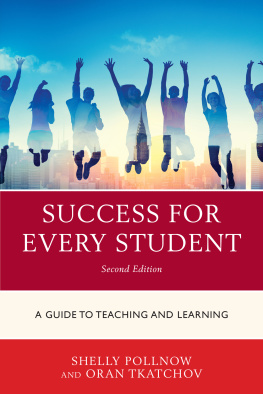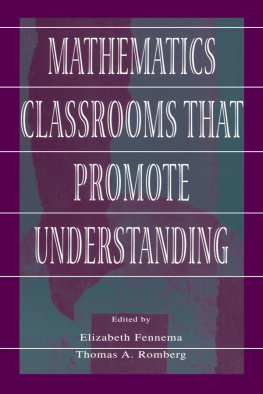Whos Being Served?
Whos Being Served?
Placing Students at the Center of Their Learning Experiences
John M. Hayward
ROWMAN & LITTLEFIELD
Lanham Boulder New York London
Published by Rowman & Littlefield
A wholly owned subsidiary of The Rowman & Littlefield Publishing Group, Inc.
4501 Forbes Boulevard, Suite 200, Lanham, Maryland 20706
www.rowman.com
Unit A, Whitacre Mews, 26-34 Stannary Street, London SE11 4AB
Copyright 2018 by John M. Hayward
All rights reserved. No part of this book may be reproduced in any form or by any electronic or mechanical means, including information storage and retrieval systems, without written permission from the publisher, except by a reviewer who may quote passages in a review.
British Library Cataloguing in Publication Information Available
Library of Congress Cataloging-in-Publication Data Available
ISBN 9781475841275 (hardback : alk. paper) | ISBN 9781475841282 (pbk. : alk. paper) | ISBN 9781475841299 (electronic)
 TM The paper used in this publication meets the minimum requirements of American National Standard for Information Sciences Permanence of Paper for Printed Library Materials, ANSI/NISO Z39.48-1992.
TM The paper used in this publication meets the minimum requirements of American National Standard for Information Sciences Permanence of Paper for Printed Library Materials, ANSI/NISO Z39.48-1992.
Printed in the United States of America
To Virginia
and other teachers like her
who entered the profession to answer a calling to serve
Preface
People who are not in education like to believe the summer months for teachers are unfair, worry-free stress breaks, but that is not true. After twelve months worth of work gets packed into nine months of time, teachers need some relief from the exhaustion. Planning activities, implementing and adjusting lesson plans, using underresourced and therefore self-purchased or created materials, and assessing student mastery of necessary skills wear on teacherseven if they are trained, degreed, and experienced.
Preparing for the school year can start as soon as the previous year ends. Putting away supplies inspires ways the next lesson can be improved, and before you know it, there goes summer.
For many teachers, back-to-school dreams begin in late July. What should be pleasant, restful summer evenings somehow turn overnight into panicked early-morning wakings of wondering why nightmares about empty bulletin boards and unruly students would even be on ones mind at this time. I should be sleeping! Why am I dreaming about not having enough photocopies made or the Internet connection failing during an official observation?
Then August begins.
Teachers anticipate their first day ever or dust off what was packed away at the end of spring and plug themselves into preparation mode. They ask, What worked before, and what can I do again? What should I not repeat? Where will I find inspirational ideas to reach my most challenging students? This equipping process includes gathering resources from anything offering something new.
Well, teachers and administrators, this book is that something new.
Within these pages are the field-tested creative sparks and researched strategies for putting students at the center of their own learning experience. Better-prepared and confident teachers create environments for prepared and confident students. In fact, these are the teachers more likely to risk letting go of control and letting students direct paths to their own learning.
In between planning, grading, reporting, decorating, constructing, counseling, and the numerous other roles there are to play as a teacher or an administrator, consult this text for ways to reset the balance and put more aspects of education into the hands of the investors and consumers.
Ownership, responsibility, the chance to risk, fail, and safely recover are what students want; they will say so if you ask them. Now is the time to be the aware, transparent, and ultimately fulfilled (not exhausted) teacher you entered this profession to become.
Putting students first does not require more work; it requires smarter work.
These chapters make multiple references to the restaurant model of understanding classroom design and instructional delivery. If you think about it, the two environments have a lot in common. As teachers welcome students to their seats each year, it helps to know what to serve and how to keep the business afloat. Just like the owners of a unique restaurant, teachers and administrators want to keep customers coming back for more and help them feel inspired to create some things on their own.
In your renewed, student-centered approach, you will be raising a new generation of students who hunger for and live, not just receive, their learning opportunities. These are the world-changers ready for the diverse challenges their future will present, and both you and your students will learn a lot in the process.
Acknowledgments
A classroom is one of the closest and neediest mission fields ever. I must credit God first for developing this calling to teach students wherever they are and to help them achieve their best. The creative ideas and insights bearing my name, the patience to slow down and see student needs, and the compassion that inspires me to get out of bed and into a school every morning are all his doing.
To Tom Koerner, vice president and education editor at Rowman & Littlefield, for reaching out to me weeks after my Educational Leadership article appeared. His encouragement to get writing helped me fill these pages in the months that followed.
To Naperville Community School District 203, whose support has fostered an environment of safe risk and discovery for me since I arrived there in 1999. Even though I would not trade my years in private schools or my second career as an adjunct writing instructor for anything, District 203 is a place I am happy to call home. To the administrators and staff, fellow teachers, students, and parents whose friendly interaction and trust has produced the environment where these ideas bounce and often land successfully, thank you.
To Mike Doman, Jackie Thornton, Dr. Lynn Andrees, Nicki Weiss, and Megan Plackett, who accommodate impromptu drive-by, idea-sharing sessions, thanks for listening and sharpening the craft. We are think-partners, and I am thankful we share the same crazy brain. Cathy Gottlieb, my fellow Learning Commons director, you have taught me so much about how the capital city of literacy operates. Thank you for your patience, leadership, and shared office space. Do I have a desk yet?
To Brian and Kelly Herkert, who believed me when I suggested their path to opening a soup and sandwich shop mirrored that of teachers preparing a classroom. We have more in common than we thought! On the cold November afternoon when I went to Everdines Grilled Cheese Company to interview you, the tomato soup really did taste like home.
To former students, from the young and near to the older and more seasoned world-changers, thank you for teaching me. Though I may not instantly recall your name if we meet face-to-face, I will remember exactly where you sat. Please keep in touch so I can read the continuing chapters of your life story.
To my family, close and extended, who have endured volumes of teacher stories, counseled years of fatigue and complaints, and celebrated many misty-eyed breakthroughs. See? It was all worth it.
Introduction
In 2015, I responded to an invitation to submit a piece to
Next page











 TM The paper used in this publication meets the minimum requirements of American National Standard for Information Sciences Permanence of Paper for Printed Library Materials, ANSI/NISO Z39.48-1992.
TM The paper used in this publication meets the minimum requirements of American National Standard for Information Sciences Permanence of Paper for Printed Library Materials, ANSI/NISO Z39.48-1992.